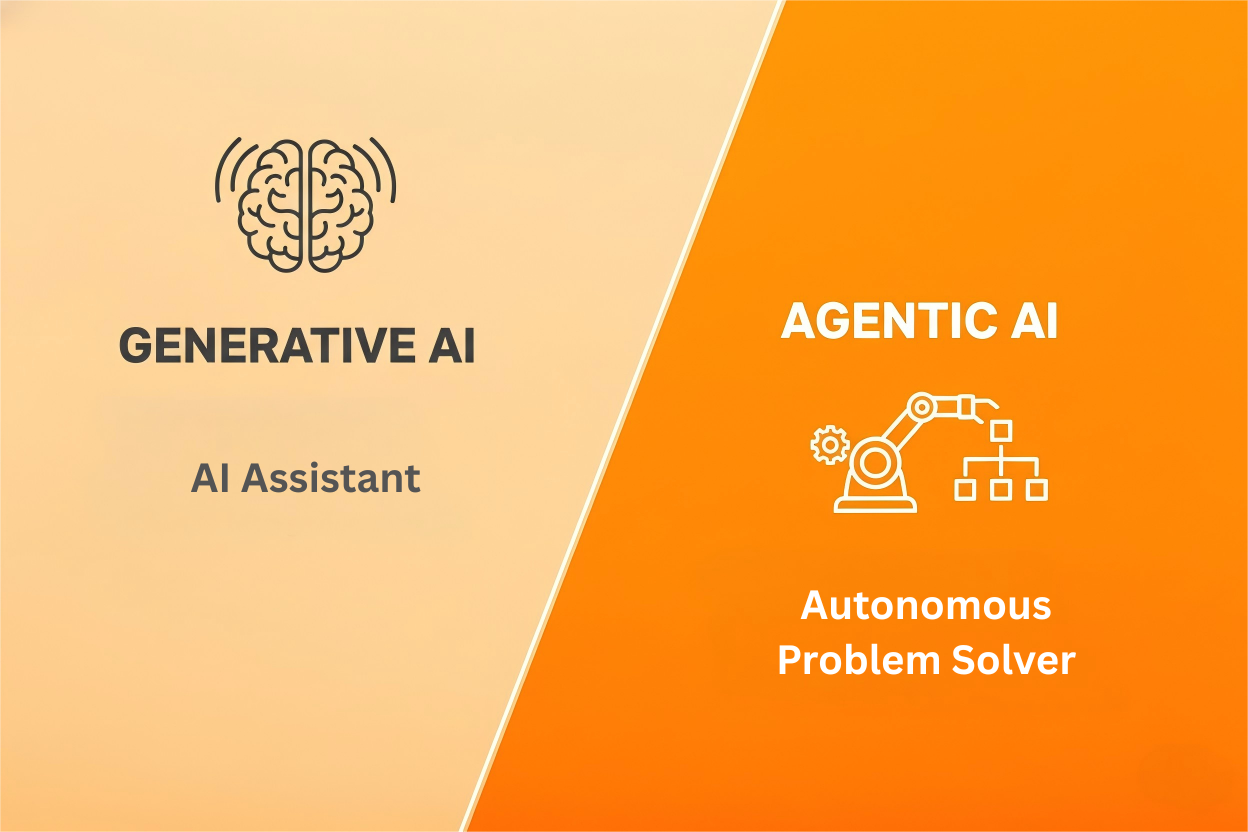Agentic AI vs. Generative AI: A Deep Dive Into Autonomy, Context, and Purpose

Artifical intelligence (AI) has become a popular term in our daily life since the launch of GenAI ChatGPT in 2022, making a turning point in how people interact with technology. As a broad and rapidly evolving field, AI encompasses many subfields - each with its own purpose and applications. Currently, the most talked-about terms are Agentic AI and Generative AI - two concepts that are fundamentally different. In reality, both play distinct yet complementary roles in shaping how AI is used in everyday life and professional tasks.
What is Generative AI?
GenAI, short for Generative AI, is a category of artificial intelligence designed to create new content based on learning from large amount of data and recognizing patterns. It can create human-like text, images, videos, audio, and code - all in response to user prompts or questions.
Generative AI relies on deep leaning models, which process massive data to identify relationships and predict what information or response best fits a given content. Unlike traditional chatbots, generative AI systems can produce unique outputs and complete more tasks. For example, ChatGPT can generate original written content, while Midjourney produces stunning images. Most generative AI applications work in an “ask-and-answer” pattern, which means that they respond directly to user inputs and prompts rather than acting independently.
What is Agentic AI?
Agentic AI is designed to work autonomously and achieve complex, multi-step tasks without constant human input. Agentic AI works based on the technology like natural language processing (NLPs) and machine learning. It can create strategies, execute plans, adpat to changing circumstances, and optimize results to achieve the defined goal.
Unlike generative AI, agentic AI is proactive. It can also interact with external systems, integrates with APIs, access tools to gather information for informed decisions. In short, generative AI creates, while agentic AI combines reasoning, memory, and autonomy to achieve goals wihout too much human supervision.
Agentic AI vs. AI Agent
Agentic AI is a broad concept referring to artificial intelligence systems capable of making autonomous decisions without much human supervision. Within this broader framework, an AI agent is a specific component designed to carry out tasks independently with a level of autonomy.
The distinction between the two is simple to visualize: imagine Agentic AI as the entire system working towards a single goal, while AI agents are the individual components within that system - each responsible for specific tasks and towards individual goal to achieve the system’s overall objective.
Agentic AI vs. Generative AI
The difference between agentic AI and generative AI is easy to grasp when you think about how they work. Generative AI acts like a talent assistant waiting for instructions and delivering answers. Instead, agentic AI works like a self-driven employee figuring out the best way to achieve work goal. In short, generative AI responds, and agentic AI acts with purpose. We’ll delve into more details in the following content.
Autonomy
Generative AI and agentic AI work in different modes. The former operates in the reactive mode, while the latter work in a proactive mode.
Generative AI cannot independently recognize problems or determine which solution are most effective. Instead, it relies heavily on human action - users must identify needs, craft prompts, analyze the generated outputs, and decide the next steps.
Agentic AI has a degree of autonomy and acts with defined goal. It can identify necessary actions, generate answers, and make decisions. Agentic AI can evaluate the potential outcomes of each action and determines how to execute them with continuous human intervention.
Purpose
The fundamental purpose of generative AI is to create content quickly and effectively. It helps users draw outlines, draft emails, generate social media posts, and create images based on the prompts. It not only saves time but also inspires new ideas, allowing users to focus on refining their work.
Agentic AI is designed to achieve specific goals autonomously. Beyond content creation, agentic AI can monitor changes, detect problems, analyze possible outcomes, and decide the best way of action.
In short, generative AI helps you to create, while agentic AI helps you act.
Adaptability
GenAI adjusts its outputs based on user inputs and it can refine or improve its responses when users provide more detailed prompts or feedback.
Compared to GenAi, agentic AI takes adaptability to the next level. It can interact with the environment, gather information autonomously, and adjust its action. In short, agentic AI is capable of proactively adapting to the changing conditions and making decision to achieve its defined goals.
Use Cases
Generative AI Use Cases
-
Content Creation:Generative AI helps create SEO optimized blogs, emails, reports, and social media posts.
-
Code Creation: Helps developers with code snippets, debugging, or boilerplate code.
-
Visual Creation: It can also generates images, logos, and videos with simple prompts.
-
Ideal Generation: Inspire users to create new ideas, concepts, and prompts.
Agentic AI Use Cases
-
Workflow Management: Agentic AI can process complex tasks like performing complex multi-step tasks and scheduling.
-
Research and Data Analysis: Collects data from different sources, evaluates outcomes, and suggests actions.
-
Customer Support: Can assess the real situation, quickly understand customers’ purpose and emotions for enhanced customer service
Future Trends of Agentic AI and Generative AI
The future of AI will not focus on Agentic AI or Generative AI in isolation, but on the synergy between the two. When these two AI categories work together, their capabilities become fa more powerful. Generative features will increasingly be embedded within agentic systems, enabling contextual content generation, adaptive strategies for dynamic situations, and more precise problem-solving. This combination will witness a new era where AI can both create and act intelligently.

